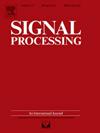Sparse representation for ℓp−αℓq minimization and uniform condition for the recovery of approximately k-sparse signals with prior support information
IF 3.4
2区 工程技术
Q2 ENGINEERING, ELECTRICAL & ELECTRONIC
引用次数: 0
Abstract
In the frame of metric, a novel lemma of sparse representation is developed. Uniform sufficient conditions for the stable recovery of approximately -sparse signals with partial support information are derived in different noise settings via weighted minimization method, and moreover, the reconstruction error bounds are precisely characterized. Specifying different values of the parameters and in the new results leads to some important special cases, including the optimal results in terms of convex minimization, nonconvex minimization, minimization, minimization and minimization in the literature. A series of numerical experiments demonstrate the advantage of the new method for sparse recovery.
具有先验支持信息的近似k-稀疏信号的最小化稀疏表示和恢复的一致条件
在 ℓp-αℓq 度量的框架内,提出了一种新的稀疏表示法。通过加权 ℓp-αℓq 最小化方法,推导出了在不同噪声设置下稳定恢复具有部分支持信息的近似 k 稀疏信号的统一充分条件,并精确地描述了重建误差边界。在新结果中,指定参数 p∈(0,1]、q∈[p,+∞]和 α∈[0,1] 的不同值会导致一些重要的特例、包括文献中的ℓ1 凸最小化、ℓp 非凸最小化、ℓ1-ℓ2 最小化、ℓ1-αℓq 最小化和 ℓp-αℓ1 最小化的最优结果。一系列数值实验证明了新方法在稀疏恢复方面的优势。
本文章由计算机程序翻译,如有差异,请以英文原文为准。
求助全文
约1分钟内获得全文
求助全文
来源期刊

Signal Processing
工程技术-工程:电子与电气
CiteScore
9.20
自引率
9.10%
发文量
309
审稿时长
41 days
期刊介绍:
Signal Processing incorporates all aspects of the theory and practice of signal processing. It features original research work, tutorial and review articles, and accounts of practical developments. It is intended for a rapid dissemination of knowledge and experience to engineers and scientists working in the research, development or practical application of signal processing.
Subject areas covered by the journal include: Signal Theory; Stochastic Processes; Detection and Estimation; Spectral Analysis; Filtering; Signal Processing Systems; Software Developments; Image Processing; Pattern Recognition; Optical Signal Processing; Digital Signal Processing; Multi-dimensional Signal Processing; Communication Signal Processing; Biomedical Signal Processing; Geophysical and Astrophysical Signal Processing; Earth Resources Signal Processing; Acoustic and Vibration Signal Processing; Data Processing; Remote Sensing; Signal Processing Technology; Radar Signal Processing; Sonar Signal Processing; Industrial Applications; New Applications.
 求助内容:
求助内容: 应助结果提醒方式:
应助结果提醒方式:


